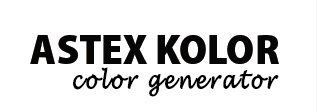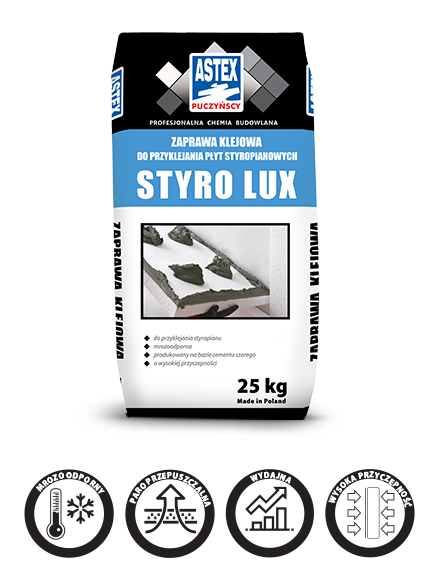Adhesive mortar for gluing STYRO LUX foam boards
It is designed for gluing foamed polystyrene boards on typical mineral substrates found in construction.
- frost resistant
- vapor permeable
- efficient
- high adhesion
Calculate expenditure
Expenditure
4,0-5,0 kg/m²
Shell life
12 months from the date of production
Packaging
25kg
Quantity on the pallet
54 pcs..
Reference document
European Technical Assessment 17/0726
Application
STYRO LUX adhesive mortar is designed for gluing foamed polystyrene boards in a jointless thermal insulation system to typical building substrates when building insulation in the ASTEX-TERM system. It is suitable for gluing foamed polystyrene boards inside and outside of buildings on substrates such as: cement plaster, cement-lime plaster, concrete, all kinds of walls made of concrete blocks, ceramic brick, expanded clay, aerated concrete, natural stones, reinforced concrete prefabricated elements, mineral, silicone plasters, etc. STYRO LUX adhesive mortar is intended for both newly build and thermally insulated constructions.
Substrate preparation
The substrate should be dry, stable, even and sound, i.e. strong enough, cleaned of layers that may weaken mortar adhesion (dust, dirt, lime, oil, fat, wax, oil and emulsion paint residues). Ground unevenness that prevents the application of the correct thickness of the STYRO LUX adhesive mortar should be corrected using materials recommended for this type of work. Excessive absorbency of the substrate should be reduced using a UNI-ASTEX priming emulsion for a minimum of 12-24 hours before sticking foamed polystyrene. Places of old plaster that raise doubts as to the adhesion should be removed and repaired with masses compatible with the ground on which they were made. In the case of filling gaps with cement or cement-lime mortar, stick foam not earlier than after 28-30 days (after the hardening process). Wet surfaces should be thoroughly dried..
Mortar preparation
Pour the contents of the package into a measured amount of water (5.5 L / 25kg) and mix using a mixer until a homogeneous mass without lumps is obtained. Wait about 5 minutes and mix again. If the mass is too thick, add a small amount of water and mix again. Spread the mortar on the surface with a steel trowel
Sticking foamed polystyrene boards
The prepared adhesive mortar should be placed on a foamed polystyrene board using the "band-to-point" method, i.e. on the periphery with 3-6 cm wide strips, and on the remaining surface with "cakes" with a diameter of approx. 8-10cm. We apply bands around the perimeter of the board at a distance of about 3 cm from the edge so that after gluing the mortar does not flow beyond the edges of the board. For boards 50x100 cm, approximately 8-10 "patches" of mortar should be applied on its central part. Correctly applied adhesive mortar should cover min. 60% of the board surface, and the thickness of the adhesive layer should not exceed 10mm. After applying adhesive mortar, the panel should be immediately applied to the wall in the place provided for it and aligned by hitting with trowel until it is an even level with the adjacent panels. If the adhesive mortar flows beyond the board outline, it must be removed. It is unacceptable to press the glued panels for the second time, as well as to correct the panels after a few minutes. Styrofoam boards should be glued in a horizontal arrangement of longer edges, maintaining the staggered arrangement of vertical joints (similar to the arrangement of bricks in the wall). Further work such as fastening fasteners, sanding polystyrene boards and laying the reinforcing layer can be carried out no earlier than after 48 hours.
Temperature of performed work
Temperature substrates from + 5 ° C to + 25 ° C air from + 5 ° C to + 25 ° C. Work should be carried out at temperatures from +5 ° C to +25 ° C. For a period of 7 days after the completion of works, the air temperature should not be below +5 ° C, and for the next 21 days should not fall below 0 ° C.
Expenditure
4,0-5,0 kg/m²
Shelf life
12 months from the date of production
Packaging
Paper sacks: 25 kg. Pallet: 54 sacks, 1350 kg
Storage and transport
The products must be absolutely stored in undamaged packaging and dry rooms on pallets. Protect from moisture, getting wet during storage and transport. The storage period of the product in conditions complying with the recommendations given is up to 12 months from the date of manufacture placed on the packaging in digital print. The date of production, which is placed on the packaging, is also the date of manufacture of the product. Any changes in the structure of the product or packaging that are visible without specialized tests, in particular discoloration or smudging of the packaging graphics, infringements of the continuity of the packaging, biological changes in the structure of the product, recognizable in particular as a consequence of moisture, may indicate poor storage or transport conditions and do not guarantee compliance declared performance characteristics of products as specified
Precautions
Irritating product. Appropriate eye, respiratory and skin protection should be used. Keep away from children. Do not breathe in dust. In case of contact with eyes, rinse immediately with plenty of water and seek medical advice. If swallowed, seek medical advice immediately and show the container or label.
Do you have questions? Doubts? Ask an advisor Contact form













